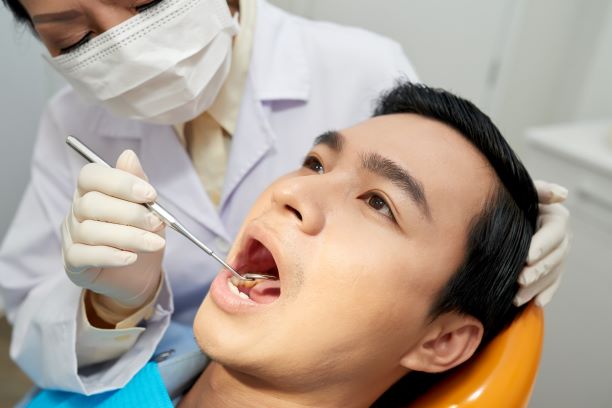Last Updated on: 5th December 2024, 10:38 am
WATCH IN STORY MODEPeriodontal abscesses are the third most common reason for consultation at dental emergency services and require immediate attention because they generate intense and rapid onset pain. In this article, we will explore everything about this type of abscess, including its causes, symptoms, and treatment.
What is a periodontal abscess?
A dental abscess is a localized accumulation of pus in the tissues that support the tooth, due to a bacterial infection. It develops rapidly, causing pain and destruction of the gum and bone. It tends to affect people who suffer from periodontal disease more frequently.

What are the causes of a periodontal abscess?
The appearance of periodontal abscesses may or may not be related to periodontitis. Periodontitis is a chronic disease in which the tissues that support the teeth are affected. If you want to know more about this pathology, you can obtain more information here.
- Periodontitis-related abscesses:
They occur as a worsening or exacerbation of periodontal disease. This occurs when the infection in the gums is not controlled, and the body responds to it with the formation of an abscess. It usually occurs due to a severe infection located in the periodontal pockets, which are spaces that form between the gum and the tooth due to the accumulation of plaque. - Abscesses not related to periodontitis:
They are those that occur in people who do not suffer from periodontal disease. They often occur due to the impaction or trapping of foreign bodies in the gum, such as food debris or pieces of dental floss. These abscesses can also occur due to anomalies in the shape of the root or root fractures, as they promote the deposition and spread of bacteria.
What are the symptoms of a periodontal abscess?
The most common signs and symptoms of a periodontal abscess are:
- Sudden, stabbing, and persistent pain.
- Redness of the gum.
- Swelling in the gum
- Pain when touching the gum
- Pain when biting or chewing
- Tooth mobility
- Pus discharge
- Bad taste in the mouth (due to pus secretion).
- Bad breath
- Severe pain that may radiate to the jaw, ear, and neck

swelling gum
Other signs and symptoms may occur indicating that the infection has spread to other parts of the body, requiring immediate treatment:
- Fever and fatigue.
- Difficulty swallowing and breathing
- Difficulty opening the mouth
- Swollen cheek
- Tenderness and swelling of the lymph nodes under the jaw.
In the presence of these symptoms, it is necessary to seek urgent medical attention, since, if the infection is not treated in time, it could worsen and affect other structures, as happens in cases of orofacial cellulitis. Failure to control the infection in a timely manner could even jeopardize the patient’s life.
How is a periodontal abscess treated?
The most important fact about the management of any infection is that it will not be permanently resolved until the cause is eliminated. Therefore, a periodontal abscess does not go away on its own and should always be treated in the dental office.
As mentioned above, an untreated tooth abscess can spread to other parts of the body, for example, the jaw and neck. Therefore, visit your dentist as soon as possible to treat the infection and relieve pain.
Typically, emergency treatment for a periodontal abscess includes drainage and the prescription of mouthwashes. To drain the abscess, it may be necessary to puncture the gum, which will allow the accumulation of pus to escape. However, this is a temporary solution and you will need other additional procedures depending on the case:
- Oral surgery
- Scaling and root planning
- Tooth extraction

oral surgery
In some cases, the dentist may recommend natural antibiotics to help control the infection and prevent its spread, especially if you are experiencing general symptoms such as fever or general malaise.
Prevention of periodontal abscess
- Good oral hygiene: Most periodontal abscesses occur in people who suffer from periodontitis, so maintaining impeccable oral hygiene is the first recommendation to avoid them. Brush your teeth properly and floss regularly to remove food debris and plaque trapped between your teeth and gums. Additionally, you can supplement brushing with a mouthwash to help prevent or reduce gingivitis.
- Avoid smoking: Smoking is one of the biggest risk factors for developing gum disease. According to the Centers for Disease Control and Prevention (CDC), smoking weakens the immune system, making it harder to fight a gum infection and also making it harder for your gums to heal.
- Maintain a balanced diet: Eat a healthy diet, drink plenty of water, and avoid sugary foods or drinks.
- Visit the dentist regularly: Your dentist can detect the early signs and symptoms of gum disease. Therefore, you can schedule your visit to the dentist in Oxnard, Santa Paula, Ventura, or Port Hueneme at least once every 6 months to remove tartar and treat gingivitis before it worsens.

oral hygiene
Other types of oral abscesses:
Like periodontal abscesses, other types of abscesses, generated by other causes, may require immediate dental management. Among them:
- Gingival abscess: It is similar to a periodontal abscess, but does not involve the destruction of the bone surrounding the tooth.
- Dental abscess, odontogenic abscess, or endodontic abscess: It occurs due to an infection originating inside the tooth.
- Apical or periapical abscess: Also known as dental abscess, odontogenic abscess, or endodontic abscess.
- Alveolar abscess: Generated in the space left after performing a tooth extraction, generally due to poor care of the area after the procedure.
- Oral space abscess: When abscesses are not controlled in time and spread to the muscle spaces, generating swelling of the cheeks.
- Odontogenic cellulitis or orofacial abscess: It happens when there is a spread of the infection to the deep spaces of the face, and it can spread to vital structures, endangering the patient’s life.
Frequently Asked Questions
To begin, it is important to note that a tooth abscess will not resolve on its own, and professional care is essential to address this condition. If a person does not seek treatment during the initial phase of a tooth abscess, the infection can persist for a period ranging from 5 months to 12 months, and may even spread further in some cases.
Bottom line: The development of a dental abscess can take several months. Once it forms, there is usually obvious pain and swelling around the affected tooth. If left untreated, the infection may require a few additional weeks or even months to spread to other tissues and cause complications.
A periodontal abscess can arise as a result of a serious gum disease, known as periodontitis, which causes the gums to separate from the teeth. This separation creates deep pockets where bacteria can proliferate. When excessive tartar builds up or food debris becomes trapped in these pockets, pus forms. If the pus cannot drain properly, an abscess forms.
No, it is not advisable to attempt to drain a dental abscess with a needle yourself. This action can expose you to a more serious infection and potentially spread the infection to other areas of your mouth and face. It is never safe to try to remove a dental abscess on your own.
Contact Us
If you have persistent pain, swollen gums, pus discharge, or pain that is worse when biting, visit Channel Islands Family Dental as soon as possible; this way, you can avoid serious complications.
At Channel Islands Family Dental, we will be focused on your visit and make a timely diagnosis. Additionally, our dentists in Oxnard, Santa Paula, Ventura, and Port Hueneme will be able to help you with the best possible treatment. Follow us on Facebook.
References:
- Higuera, V. (Feb 26, 2018). Gum abscess. Healthline. https://www.healthline.com/health/gum-abscess
- Johnson, J. (Jan 27, 2020). Gum abscess: Treatment, home remedies, symptoms, and more. Medicalnewstoday.com. https://www.medicalnewstoday.com/articles/gum-abscess
- Periodontal abscess. (2023). Cleveland Clinic. https://my.clevelandclinic.org/health/diseases/24573-periodontal-abscess
- Periodontal abscess. (2021). HSE.Ie. https://www.hse.ie/eng/services/list/2/gp/antibiotic-prescribing/conditions-and-treatments/dental/periodontal-abscess/
- What causes a tooth to abscess? (Jan 17, 2022). Dental Health Society. https://dentalhealthsociety.com/general/what-causes-a-tooth-to-abscess/
- Yousefi, Y., Meldrum, J., & Jan, A. H. (2023). Periodontal Abscess. StatPearls Publishing.






